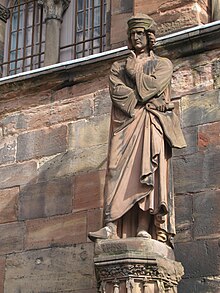Erwin von Steinbach
When Erwin took charge of the construction, the cathedral was completed except the porch of the tower, and reflected in its parts the development of architectural styles from the first quarter of the eleventh century.Three plans of the façade are still in existence; according to German art historian Georg Dehio, the best design belongs to Erwin, to whom it is customary to ascribe the entire construction.The somewhat peculiar ornamentation consists of a double tracery of bars and geometrical designs which covers the façade like a net dividing and filling the large surfaces.By the novelty and the daring of the new style the individual members of this façade are in marked contrast to the older parts of the building; the front, moreover, is connected directly with the body of the cathedral.The ornamental sculpture of the building, which is richer than that ordinarily found in German cathedrals, is attributed to Erwin's workshop, from which came also the monument to Conrad of Lichtenberg (1240–1299) in the chapel of St. John.


Philippe GrassarchitectStrasbourg CathedralSteinbachBaden-BadenStraßburgBavariaAustriafaçadeNotre-Dame de StrasbourgNiederhaslach ChurchFrench Gothicarchitectural stylesart historianGeorg DehioJohann Wolfgang von Goetherose windowtracerysculptureConrad of LichtenbergBlessed VirginSabina von Steinbachpublic domainCatholic EncyclopediaChisholm, HughEncyclopædia Britannica